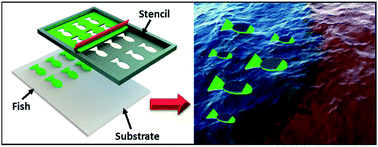Self-propelled screen-printable catalytic swimmers†
Abstract
A highly versatile 2D screen-printing fabrication of nature-inspired fish swimmers is described. The new screen-printing approach offers large-scale cost-effective fabrication of efficient multi-functional chemically-powered motors. Diverse fish architectures, consisting of several predesigned printed layers, including the mid-body, head, tail, and an entire fish, are achieved by printing different functional inks through the corresponding patterned stencils. The 2D fish-printing approach allows fine control of the shape, size, functionality and performance of the resulting fish swimmers. In particular, different functionalities can be incorporated at specific areas by sequential printing of specific layers based on different modified inks. For example, printing of catalytic tails containing various Pt loadings has been used to prepare fish with different propulsion efficiencies. Inks based on activated carbon powder have been used for accelerated removal of chemical pollutants. Nickel-containing carbon ink has been used for magnetic control of the fish directionality. This screen-printing fabrication route can be readily extended for incorporating other functional materials into one swimmer structure. Such a versatile, simple, scalable, fast, and cost-effective approach holds considerable promise for creating biomimetic swimmers with different properties for diverse practical applications.


 Please wait while we load your content...
Please wait while we load your content...